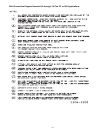
48
PURGE
Supply Fan - On
Inlet Vanes - Open (if equipped)
Exhaust Fan - On (if equipped)
Exhaust Dampers - Open (if equipped)
OA Dampers - Open
Heat - All heat stages Off (staged gas and elec.), Hydronic
heat & Mod Gas Heat output at 0%.
Occupied/Unoccupied output - Energized
VO Relay - Energized (with VOM module installed)
OA Preheater State - Off (with VCM module installed)
SHUTDOWN
Supply Fan - Off
Inlet Vanes - Closed (if equipped)
Exhaust Fan - Off (if equipped)
Exhaust Dampers - Closed (if equipped)
OA Dampers - Closed
Heat - All heat stages Off (staged gas and elec.), Hydronic
heat & Mod Gas Heat output at 0%.
Occupied/Unoccupied output - De-energized
VO Relay - Energized (with VOM module installed)
OA Preheater State - Off (with VCM module installed)
FIRE
Supply Fan - Off
Inlet Vanes - Closed (if equipped)
Exhaust Fan - Off (if equipped)
Exhaust Dampers - Closed (if equipped)
OA Dampers - Closed
Heat - All heat stages Off (staged gas and elec.), Hydronic
heat & Mod Gas Heat output at 0%.
Occupied/Unoccupied output - De-energized
VO Relay - Energized (with VOM module installed)
OA Preheater State - Off (with VCM module installed)
Emergency Stop Switch (5S71)
A normally closed (N.C.) switch (5S71) wired to the RTM
may be used during emergency situations to shut down all
unit operations. When opened, an immediate shutdown oc-
curs. An emergency stop diagnostic is entered into the Hu-
man Interface and the unit must be manually reset. Refer to
the appropriate illustrations in Figure 3-16 or 3-17 for the
proper connection terminals in the unit control panel. The
switch must be rated for 12 ma @ 24 VDC minimum.
Occupied/Unoccupied Contacts (5K86)
To provide Night Setback control if a remote panel with NSB
(5U58) was not ordered, a field supplied contact (5K86)
must be installed. This binary input provides the Occupied/
Unoccupied status information of the building to the RTM. It
can be initiated by a time clock, or a Building Automation
System control output. The relay’s contacts must be rated
for 12 ma @ 24 VDC minimum. Refer to the appropriate il-
lustrations in Figure 3-16 or 3-17 for the proper connection
terminals in the unit control panel.
Demand Limit Relay (5K89)
If the unit is equipped with a Generic BAS Module (1U51),
(i.e. unit model number digit 21+ is a “K”), a normally open
(N.O.) switch may be used to limit the electrical power us-
age during peak periods. When demand limit is initiated, the
mechanical cooling and heating operation is limited to either
50% or 100%. Demand limit can be initiated by a toggle
switch closure, a time clock, or an ICS
TM
control output.
These contacts must be rated for 12 ma @ 24 VDC mini-
mum.
Outside Air Sensor (3RT3) - BAYSENS016A
This device senses the outdoor air temperature and sends
this information in the form of an analog input to the RTM.
It's factory installed on units with an economizer, but can be
field provided/installed and used for informational purposes
on units without an economizer. Refer to the appropriate il-
lustrations in Figure 3-16 or 3-17 for the proper connection
terminals in the unit control panel. Refer to Table 3-10 for
Temperature vs Resistance coefficient.
Generic Building Automation System (1U51)
The Generic Building Automation System (GBAS) module
allows a non-Trane building control system to communicate
with the rooftop unit and accepts external setpoints in form
of analog inputs for cooling, heating, demand limiting, and
supply air pressure parameters. Refer to Figure 3-18 for the
input wiring to the GBAS module and the various desired
setpoints with the corresponding DC voltage inputs for both
VAV and CV applications.
For complete application details of the module, refer to
Engineering Bulletin UN-PRB001-EN.
Resistance Resistance
Temperature (F) (in. 1000 Ohms) Temperature (F) (in. 1000 Ohms)
-40 346.1 71 11.6
-30 241.7 72 11.31
-20 170.1 73 11.03
-10 121.4 74 10.76
-5 103 75 10.5
0 87.56 76 10.25
5 74.65 77 10
10 63.8 78 9.76
15 54.66 79 9.53
20 46.94 80 9.3
25 40.4 85 8.25
30 34.85 90 7.33
35 30.18 100 5.82
40 26.22 105 5.21
45 22.85 110 4.66
50 19.96 120 3.76
55 17.47 130 3.05
60 15.33 140 2.5
65 13.49 150 2.05
66 13.15 160 1.69
67 12.82 170 1.4
68 12.5 180 1.17
69 12.19 190 0.985
70 11.89 200 0.83
Table 3-10 - Temperature vs. Resistance Coefficient
The UCM network relies on various sensors located
throughout the system to provide temperature information in
the form of an analog input. All of the sensors used have
the same temperature vs. resistance co-efficient and are
made from Keystone Carbon D97 material with a 1 degree
Centigrade tolerance.


















